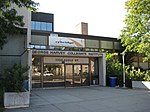York, Toronto
1998 disestablishments in OntarioAC with 0 elementsBlack Canadian culture in TorontoBlack Canadian settlementsFormer cities in Ontario ... and 4 more
Former municipalities in TorontoMetropolitan TorontoNeighbourhoods in TorontoPopulated places disestablished in 1998

York is a former city within the current city of Toronto, Ontario, Canada. It is located northwest of Old Toronto, southwest of North York and east of Etobicoke, where it is bounded by the Humber River. The city has a population of 145,662 as of 2016. As a separate city, it was one of six municipalities that amalgamated in 1998 to form the current city of Toronto. The City of York was created by the amalgamation of several villages, including the present-day neighbourhoods of Lambton Mills and Weston. The city has a diversified character and is home to a number of Italian, Portuguese and Jamaican neighborhoods.
Excerpt from the Wikipedia article York, Toronto (License: CC BY-SA 3.0, Authors, Images).York, Toronto
Eglinton Avenue West, Toronto York
Geographical coordinates (GPS) Address Nearby Places Show on map
Geographical coordinates (GPS)
| Latitude | Longitude |
|---|---|
| N 43.689829 ° | E -79.478066 ° |
Address
York Civic Centre
Eglinton Avenue West 2700
M6M 1T9 Toronto, York
Ontario, Canada
Open on Google Maps










